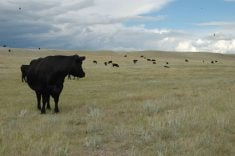SASKATOON – The day of the single-person veterinary practice in small prairie towns is coming to an end, say officials from the Saskatchewan Veterinary Medical Association.
And when small-town mixed practice veterinarians begin to disappear, so will farmers’ convenient access to livestock medicine.
Curt Hagele of the Saskatchewan Veterinary Medical Association has told the Saskatchewan government that the veterinary profession is nearing “crisis level.”
He said 20 percent of rural practitioners are at or nearing retirement. The average age among Saskatchewan veterinarians is 55 years.
Read Also

Soybean market still figuring out implications of China-U.S. pact
Soybean futures had a muted reaction to the U.S. trade deal with China as the market tries to figure out the nuances of the deal.
“Many of today’s veterinarians don’t want or will not practise until they are 65 or 70 … like the last generation did,” Hagele said.
Alexander Livingston, dean of the Western College of Veterinary Medicine at the University of Saskatchewan, has an intimate understanding of the problems facing the profession.
As the person in charge of minting new veterinarians, Livingston said the number of new large animal vets coming into the system is not keeping pace with the number of retirements.
“Years ago, vets would practise for 35 or 40 years,” Livingston said.
“Today is more like 20 or 25. That means 25 or 30 percent fewer vets in the system for that reason alone.
“…(It) is like any other profession out there. It is hard to attract a lawyer or a doctor or an accountant to a rural area in Western Canada.”
Those in the industry say many small rural communities will lose their veterinarians in the near future.
Instead, multiple-person practices based in larger communities will replace the single vet clinics. Farmers will have to pay higher fees for vet services or
will have to travel longer distances for emergency care.
The SVMA and associations in the other western provinces say cases of burnout, injury and disability are rising among rural practitioners.
Long days in spring and fall, understaffing, high education expenses and low pay relative to other skilled professions have made the choice of rural practices less than attractive to many younger vets.
Last year, the average net income for a rural, mixed practice owner in Saskatchewan was around $50,000.
Veterinarian Gary Hoium of Weyburn, Sask., put his multiple vet practice up for sale last year.
Inquiries have been slow.
“So far, two… two calls on it,” Hoium said.
Hoium’s business is bigger than most. His practice has one seasonal and three full-time vets. He has upgraded his facilities with a retail outlet for drugs and animal supplies, expanded his treatment area and added warehouse space.
His should be the future of centralized mixed practice medicine. Still, he has seen little interest from potential buyers.
“It has provided us with a good living and it would provide the new owner with one too. As soon as we find that person.”
Hoium said at 44, he is ready to retire from large animal work.
“Joint and back injuries from handling cattle for (17) years have taken their toll. I’m starting to wear out,” he said.














